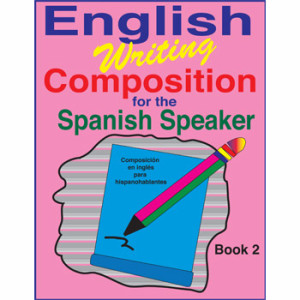Vocabulary
English Vocabulary for the Spanish Speaker is one of the four series in our English literacy program for Spanish-speaking teens and adults. This literacy program is made up of a collection of workbooks. The vocabulary series helps Spanish speakers increase their English vocabulary. Each vocabulary workbook reviews the vocabulary that was introduced in the other three series in our English literacy program. The other series in this program are:
English Reading and Spelling for the Spanish Speaker
English Reading Comprehension for the Spanish Speaker
English Writing Composition for the Spanish Speaker.
Each series in the literacy program is a collection of six workbooks. Each workbook is bilingual with the directions in Spanish and activities in English. There is an English translation of the Spanish directions at the back of each workbook.
Below are the English and Spanish Table of Contents from English Vocabulary for the Spanish Speaker Book 1.
Contents
Introduction………………………………………………………………………………………………………………………. v
Dictionary…………………………………………………………………………………………………………………………. 1
Nouns………………………………………………………………………………………………………………………………. 6
Verbs……………………………………………………………………………………………………………………………….. 8
Plurals……………………………………………………………………………………………………………………………. 11
Adjectives………………………………………………………………………………………………………………………. 15
Animals………………………………………………………………………………………………………………………….. 17
Places……………………………………………………………………………………………………………………………. 23
Things……………………………………………………………………………………………………………………………. 25
Numbers………………………………………………………………………………………………………………………… 30
Colors…………………………………………………………………………………………………………………………….. 32
Words with Multiple Meanings…………………………………………………………………………………………. 34
Rhyming Words………………………………………………………………………………………………………………. 36
Feelings…………………………………………………………………………………………………………………………. 40
Contractions………………………………………………………………………………………………………………….. 41
More Animals………………………………………………………………………………………………………………… 43
Random Words…………………………………………………………………………………………………………….. 48
Random Pictures………………………………………………………………………………………………………….. 50
Food and Clothes…………………………………………………………………………………………………………. 52
Transportation……………………………………………………………………………………………………………… 54
People…………………………………………………………………………………………………………………………… 55
Analogies………………………………………………………………………………………………………………………. 57
Sounds………………………………………………………………………………………………………………………….. 58
More Verbs……………………………………………………………………………………………………………………. 60
Homophones………………………………………………………………………………………………………………… 63
Synonyms…………………………………………………………………………………………………………………….. 64
Categories…………………………………………………………………………………………………………………….. 65
Answer Key…………………………………………………………………………………………………………………… 66
English Translation of Spanish Directions………………………………………………………………………… 75
Index……………………………………………………………………………………………………………………………… 82
Contenido
Introducción……………………………………………………………………………………………………………………… v
Diccionario……………………………………………………………………………………………………………………….. 1
Sustantivos……………………………………………………………………………………………………………………… 6
Verbos…………………………………………………………………………………………………………………………….. 8
Plurales………………………………………………………………………………………………………………………….. 11
Adjetivos……………………………………………………………………………………………………………………….. 15
Animales……………………………………………………………………………………………………………………….. 17
Lugares…………………………………………………………………………………………………………………………. 23
Cosas……………………………………………………………………………………………………………………………. 25
Números………………………………………………………………………………………………………………………… 30
Colores………………………………………………………………………………………………………………………….. 32
Palabras con múltiples significados………………………………………………………………………………….. 34
Palabras que riman…………………………………………………………………………………………………………. 36
Sentimientos………………………………………………………………………………………………………………….. 40
Contracciones……………………………………………………………………………………………………………….. 41
Más animales……………………………………………………………………………………………………………….. 43
Palabras ocasionales…………………………………………………………………………………………………….. 48
Imágenes ocasionales…………………………………………………………………………………………………….. 50
Alimentos y Ropa…………………………………………………………………………………………………………. 52
Transporte……………………………………………………………………………………………………………………… 54
Personas……………………………………………………………………………………………………………………….. 55
Analogías……………………………………………………………………………………………………………………… 57
Sonidos…………………………………………………………………………………………………………………………. 58
Más verbos…………………………………………………………………………………………………………………… 60
Homófonos……………………………………………………………………………………………………………………. 63
Sinónimos……………………………………………………………………………………………………………………… 64
Categorías…………………………………………………………………………………………………………………….. 65
Las Respuestas……………………………………………………………………………………………………………… 66
Traducción al inglés de las instrucciones en español………………………………………………………….. 75
Índice………………………………………………………………………………………………………………………….. 82
Visit our website at www.Fisher-Hill.com to read more about our English Vocabulary for the Spanish Speaker series and the other series in our English literacy program for Spanish Speakers.







